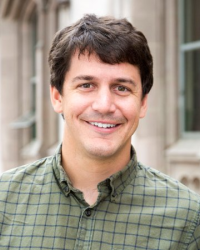
Contact Information
Fields of Interest
Biography
Nanopores, essentially nanometer scale holes, can be used as extremely powerful nano-scale sensors. In a typical nanopore experiment, an ion current is made to flow through the nanopore and the nanopore serves as the primary resistor within a circuit. Anything that modifies the conductivity of that nanopore, such as a DNA molecule translocating through the pore, alters the ion current signal. Because the ion current is focused through such a small volume (~1 nm cubed), even small changes like the addition or subtraction of a few atoms to a DNA base, are amplified into an easily measured electrical signal. This serves as the basis for nanopore DNA sequencing, in which different DNA bases within the pore can be distinguished based on their differing electrical signals. My work centers on improving Nanopore Sequencing of DNA.
Single-molecule Picometer Resolution Nanopore Tweezers (SPRNT) arose from our work developing nanopore DNA sequencing. We realized that nanopore sequencing allowed for the study of how enzymes that walk along DNA work at a resolution orders of magnitude better than the current state-of-the-art in single-molecule techniques. SPRNT can apply both assisting and opposing forces and observe how these forces affect the single-nucleotide steps thereby dissecting the mechanokinetics of these enzymes at phenomenal detail. Our group is developing SPRNT into a fully fledged single-molecule technique and applying it to the study of helicases and polymerases. Recently, I have begun a project using SPRNT to analyze the helicase and polymerase from SARS-CoV-2, the virus responsible for COVID-19. SPRNT should shed light on how these enzymes function and hopefully provide insight into how they can be stopped.
Research
Selected Research
- Christopher A Thomas, Jonathan M Craig, Shuichi Hoshika, Henry Brinkerhoff, Jesse R Huang, Sarah J Abell, Michaela C Franzi, Jessica D Carrasco, Hyo-Joong Kim, Drew C Smith, Jens H Gundlach, Steven A Benner, Andrew H Laszlo. "Assessing Readability of an 8-letter expanded deoxyribonucleic acid alphabet with nanopores." Jour. Amer. Chem. Soc. April 2023. https://doi.org/10.1021/jacs.3c00829Adviser: Andrew H Laszlo, Adviser: Jens Gundlach
- Sinduja K Marx, Keith J Mickolajczyk, Jonathan M Craig, Christopher A Thomas, Akira M Pfeffer, Sarah J Abell, Jessica D Carrasco, Michaela C Franzi, Jesse R Huang, Hwanhee C Kim, Henry Brinkerhoff, Tarun M Kapoor, Jens H Gundlach, and Andrew H Laszlo. "Observing Inhibition of the SARS-CoV-2 helicase at single-nucleotide resolution." Nucleic Acids Research. August 2023. https://doi.org/10.1093/nar/gkad660.Adviser: Andrew H Laszlo, Adviser: Jens Gundlach
- A. H. Laszlo, J. M. Craig, M. Gavrilov, R. Tippana, I. C. Nova, J. R. Huang, H. C. Kim, S. J. Abell, M. deCampos-Stairiker, J. W. Mount, J. L. Bowman, K. S. Baker, H. Higinbotham, D. Bobrovnikov, T. Ha, J. H. Gundlach, Sequence-dependent mechanochemical coupling of helicase translocation and unwinding at single-nucleotide resolution. Proc. Natl. Acad. Sci. 119, e2202489119 (2022).
- MspA nanopore as a single-molecule tool: From sequencing to SPRNT. AH Laszlo, IM Derrington, JH Gundlach. Methods 105, 75-89Adviser: Jens Gundlach
- Decoding long nanopore sequencing reads of natural DNA. AH Laszlo, IM Derrington, BC Ross, H Brinkerhoff, A Adey, IC Nova, et al. Nature Biotechnology 32 (8), 829-833Adviser: Jens Gundlach
Research Advised
- Kawabe, H., Thomas, C.A., Hoshika, S. et al. Enzymatic synthesis and nanopore sequencing of 12-letter supernumerary DNA. Nat Commun 14, 6820 (2023). https://doi.org/10.1038/s41467-023-42406-z
- Christopher A Thomas, Jonathan M Craig, Shuichi Hoshika, Henry Brinkerhoff, Jesse R Huang, Sarah J Abell, Michaela C Franzi, Jessica D Carrasco, Hyo-Joong Kim, Drew C Smith, Jens H Gundlach, Steven A Benner, Andrew H Laszlo. "Assessing Readability of an 8-letter expanded deoxyribonucleic acid alphabet with nanopores." Jour. Amer. Chem. Soc. April 2023. https://doi.org/10.1021/jacs.3c00829
- Sinduja K Marx, Keith J Mickolajczyk, Jonathan M Craig, Christopher A Thomas, Akira M Pfeffer, Sarah J Abell, Jessica D Carrasco, Michaela C Franzi, Jesse R Huang, Hwanhee C Kim, Henry Brinkerhoff, Tarun M Kapoor, Jens H Gundlach, and Andrew H Laszlo. "Observing Inhibition of the SARS-CoV-2 helicase at single-nucleotide resolution." Nucleic Acids Research. August 2023. https://doi.org/10.1093/nar/gkad660.